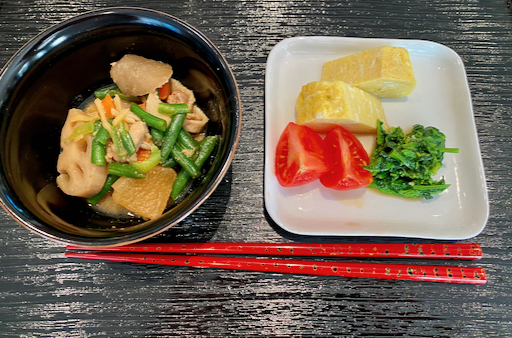We have been getting gourmet meat such as duck and lamb from D’Artagnan. This time, we got an email promotion from them for pork belly from young pig called “porcelet”. Since we have not had pork belly (from adult pig or otherwise) for sometime (we usually get it from Whole Foods), we decided to give it a try. It arrived hard chilled with skin on. It was also much larger than we expected. Although the ad said it was 6 lbs. it was essentially half of the entire belly and we realized that in its present shape it probably would not fit in our freezer so I immediately divided it into three portions. I vacuum packed and froze two and thawed one. I made several dishes from the one piece I thawed. One dish is shown below. I thinly sliced a small portion while it was semi frozen. This preparation is called “buta-bara komagire” 豚バラ細切れ and is usually used to “season” other ingredients, mostly vegetables, rather than served as a “meat dish”. I used it to make a Japanese style miso simmered dish with root vegetables. The original recipe came from erecipe, a Japanese recipe site. One evening I served this dish (left) with dashi-maki omelet, rapini buds (substitute for “nanohana” 菜の花 dressed in mustard-soy sauce or “karashi-jouuyu” 辛子醤油 and skinned Campari tomato.
150 gram (1/3 lb) Pork belly, thinly sliced
1 carrot, medium, peeled and cut into bite size (“rangiri” 乱切り).\
Lotus root (renkon), I used frozen already cut ino slices, I used 4 which was cut into half circle.
1/3 Gobo burdock root, skin scraped off and cut into bite size (“rangiri”), soak it in vinegared or acidulated water until use (this is my addition since I had some left over gobo)
1 small piece of ginger root, skin scraped off and cit into julienne.
Simmering liquid
150 ml Japanese both
3 tbs sake
1 tbs mirin
1 tbs sugar
2 tbs miso
1 tsp soy sauce (this is added at the end of cooking)
Directions:









.jpeg)



.jpeg)


